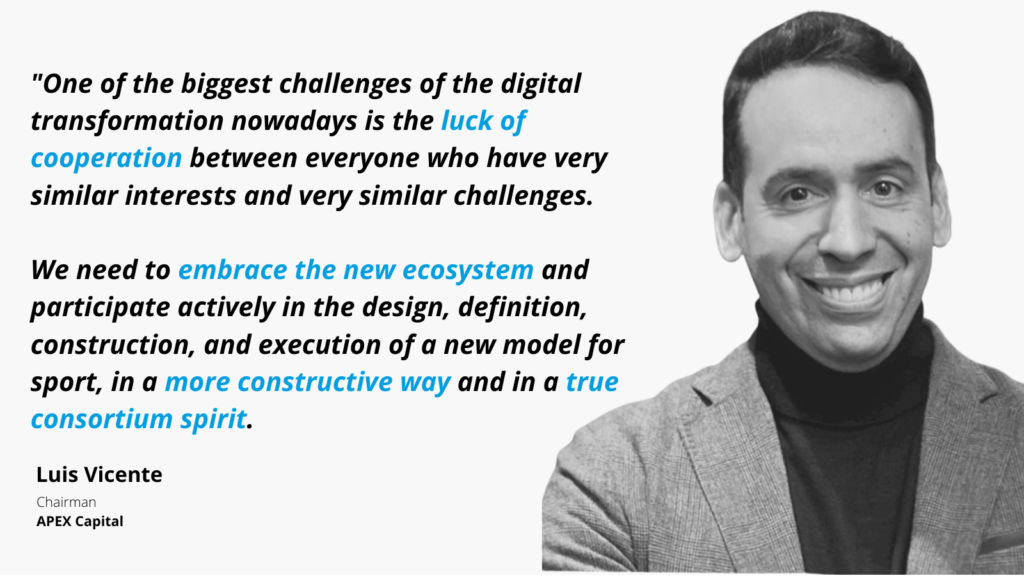01 Nov Have you met…Luis Vicente? – The importance of joint effort and cooperation in the sport tech ecosystem
Sports Industry and Sports Transformation Leader with over 28 years’ experience in General management, Commercial growth, Talent management, Business development, Relationship management, Brand development, Sports Innovation, Digital, Technology and Analytics, Transformation in Sports and Sports Leadership.
Managed, worked for and advised Luis Figo, Ronaldo, Andryi Shevchenko, Roberto Carlos, Robinho, Luiz Filipe Scolari, Carlos Queiróz, Red Bull, Ferrari, Lotus, Manchester City, Real Madrid, Ac Milan, Valencia CF, Portuguese F.A., Brazilian F.A., La Liga – Spanish Football League, Liga Portugal – Portuguese Football League, United Nations, Luis Figo Foundation, Qualcomm, Microsoft, 7League
Over the last 12 years, assumed a leading role as sports transformation evangelist, working in senior executive roles or provide C-level consultancy services to some of the world’s greatest brands in multiple sports: Red Bull, Ferrari, Lotus, A1GP, Manchester City FC, Valencia CF and FIFA, International Media Groups like Eleven Sports and as well as assuming leading roles at commercial and innovation working groups at global soccer organizations such as the Premier League, La Liga or ECA, the European Club Association. He is a also a well-known speaker participating regularly at some of the world leading sports business forums such as World Football Summit, Soccerex, Leaders in Football, Stadium Business Summit or Stadium Coliseum and a founding member of the Judging Panel of Leaders Under-40 and Leaders in Sports Awards.
Question: How does the digital transformation of sport landscape looks like to you nowadays?
Answer: For me, digital transformation in sports is a life mission because it requires patience and takes time. When we talk about the sports industry, we’re not talking about one single industry only, we’re talking about hundreds of different sports, with very different identities and development levels, united under one umbrella. And it’s not easy to look at ways it can be driven by the joint effort of the entire ecosystem.
For at least the last 30 years, there have been three entities that are in control of the most important decisions and that have created a centralized model around the industry. Those are the rights holders, especially the ones from professional sports of highest magnitude, broadcasters and media partners, which play a fundamental role to provide the model and the monetization streams that have been essential for the development of the industry and of course, the commercial partners that have not just generated financial resources, but also have pushed brand, experience and awareness of sports into a large spectrum.
I believe that today we are starting to see a decentralization phenomenon pushed by the relevance and the impact of a new holy trinity in sports, that are taking more relevance and are forcing a new model. We are still in the beginning of this journey and current can watch a co-existence between the two.
Under this new trinity, we have technology and data companies as a result of the impact and relevance that technology have in nowadays world, but specially data is at the center of maybe sports biggest step forward. I believe there is still somehow a misunderstanding and adversity towards technology from sports sometimes, because sometimes sports businesses don’t understand the relevance, they are afraid of what it can do, and some think that it can destroy the values and the ways to do things of well-established sports institutions.
If sports companies can think as technology companies do, we will have a fundamental shift, from simple processes like being capable because of piloting new ideas, prototyping, and developing cases, as well as understanding that the creation process.
Sports still need to evolve on that, but technology companies, especially the ones working with data, are presenting today, a massive opportunity for the industry to grow and in a way, they are taking a certain dominant position, because they are the ones who are able to create bidirectional relationship with the user and the fan, something that is somehow difficult to replicate in sports.
The second party related with Athletes and Fans.
The athlete has a growing role and are building important movements especially the athlete entrepreneurs. Athletes do have the same foundational design as an entrepreneur because they have to deal with fearless competition and the unexpected on a daily basis. Most of the times, talent is not enough, and you must build a stiffness, you have to be very robust psychologically, you have to manage the rules and deal with many ups and downs. These are the same challenges you must face on the early start of your business.
We can see now in United States and in Europe how many athletes are investing in entrepreneurship and in many early-stage businesses, and I think that’s an amazing opportunity for both parties.
Digitalization brought in a democratization of access, while maybe 30 years ago, it was very different for athletes sometimes to express their point of view, because they had to use their media time, which was very confined to TV. Today, athletes can manage their own channels and amplify and personalize their messages. It’s a very powerful combination.
Another driving force with their own voice are sports fans. For some reason, sports properties look sometimes to be “afraid” to let fans to really be involved on A-to-Z decisions and having na wider influence. But I think the process of amplifying fan relevance is unstoppable. We live in the world of co-creation and collaboration where every fan can have a voice and a chance of giving their opinion. We’re talking about not just one, but millions of people sharing their opinions on the same subject, creating discussion with rights holders and institutions that run sports. And I think that’s an unbelievable opportunity.
And finally, there’s also a very interesting point about investors. Sports have always tried to generate their own self-sufficient resources and in a way has been mostly adverse in terms of welcoming external private investment, except, probably, in United States. I think, investors can bring to sport much more than just money: they can bring different points of view, transfer know-how from other high growth industries and talent from other businesses that can have a different angle. At the end sport as a business is many businesses in one: it is a community business, a content business, a digital business and much more. We need more expertise from these areas, we need to have a mid- and long-term vision and executional strategy.
I believe this evolutional phase in sports will allow for an effective shift. It will be not about digital transformation, but about having digital at the center of anyone’s strategy and roadmap.

Q: What are the main challenges of the digital transformation that we are facing?
A: I think the misunderstanding and somehow fear of change provoked by the new ecosystem we just talked about is a massive first challenge. Many tend to fear what they can’t understand but, in this case, we need to do the opposite. We need to embrace it and participate actively in the design, definition, construction, and execution of a new model for sport, in a more constructive way and in a true consortium spirit.
The second one, which also I think is very important, is the impact of legacy. And this is a difficult one. Sometimes it’s easy to use innovation and do transformation when you don’t have a historical legacy, because you can redesign an existing ecosystem more quickly. But when you have 20-30 years of legacy contracts, or you have 40-50 years of legacy of commercial models, it is very difficult to do innovation at scale and change all that.
Many of the big sports organizations today are still tied up to contracts that are not even previewing social media or digitalization at scale. So as much as you want to change that as innovative leader and innovative stakeholder, it takes time. And unfortunately, due to the dominant short-term perspective, you can also find yourself in a situation where there is not enough time to do it.
The third one is the lack of cooperation and creation of a joint effort between everyone who have very similar interests and very similar challenges. We all know that sport is about competition and rivalry, heroes, drama, and fantastic rich storytelling with ups and downs. Sports organizations often bring that same competitiveness to the areas where they should cooperate with one another. We all should innovate together because it is easy to innovate when you’re only beginning. When you are in the dimension of a league, which is very competitive, clubs don’t really like to work together. But when someone has more courage to advance, it works, and I saw that in my career so many times.
The last one is not the easy one. A large majority of the current Sport Industry Leadership aren’t digital natives. This brings complexity on understanding the new models and new ways that digital economy brings, which reduces the courage and the trust to move from a safe to a more risk-taking culture. And innovation sometimes is also about taking risks. Current sports business models are driven by risk avoidance and guaranteed revenue. I believe sometimes you need to have some more clever thinking on that. But it’s very difficult for the current generation to deal with a full-scale transformation and is not because no one is trying to do it, or they are doing the wrong job. There’s no right or wrong here, it’s just an additional challenge. I believe that when the first digital native generation will be in conditions to take over, we will see a much wider change.
These are the four main challenges we have, but the opportunity is immense. And I think step by step, centimeter by centimeter, we will gain more strength to continue, to push and to deliver the best results in the shortest time possible.
Q: For you, which is the best working model between a sport entity and a startup?
A: I’ll try to give a view on the two angles. Today startups have a massive, important role to play in the sports ecosystem, because there are things that only open innovation can do. Open innovation allows people that are not so involved in the day-to-day operations and problems, and who have different perspectives, to understand the real issues and build effective solutions much deeper.
I think being an entrepreneur, and presenting very innovative approaches to historical problems, or new problems, or problems that the industry sometimes doesn’t even realize it’s going to have in a few years, is unbelievably important. Luckily, many rights holders I’ve been looking at are keen to organize their own incubator or an accelerator, but especially to work with different expertise in the industry and joining efforts in collaboration.
For the startups side, there is also a special piece of advice, because I meet hundreds of startups and creators every year, which is an amazing experience. Many times, people are so passionate about the problem they’re trying to solve, that they focus only on that problem. And you need to understand what happens on the sports side, and that problem you’re solving is only a part of a much bigger problem. This also comes from something that I see and that I’ve been trying to fight for many years: in sports, people have resistance of working together, and sometimes startups also have this resistance. I’ve been in many jury panels, including GSIC initiatives, and I always try to incentivize different entrepreneurs to work together, because you can build a fantastic global solution for a global problem out of joining up all these efforts, and all these great and creative people, and the work they are doing. I think it’s an area of opportunities that has a massive scalability, but we just need to learn how to work together and understand that a true collaboration spirit is fundamental.
Q: How important do you think it is for a government or a public institution to be involved in open innovation processes and support entrepreneurs and local businesses?
A: Of course, is very, very important, and for me, as latest example, it has been great to see what GSIC and Andorra Government have done together. It’s great that a country had the courage and the vision to look to sports as the basis for an innovation beacon to attract investment, talent, and launch massive amount of opportunities for the younger generations, as well offering a very interesting tissue of development for the local businesses and talent. We know from many other areas in innovation, that open innovation has been the beacon of many countries around the world with proven results.
Andorra has a great strategic plan around this area with some of the elements that are going to be extremely relevant for sports with a massive scalability to other areas. It includes athletes, esports, fintech and blockchain, which for me will provide a massive power to once and for all create a bidirectional relationship between sports and its audience, new ways for digital monetization and the effective merger of real and virtual in the metaverse. I think what Andora is doing has been refreshing, I really applaud the courage, the vision, and I believe it’s going to be very successful. If I look where Andorra can be in 10-15 years from now on, developing wisely this strategy, I think it’s going to be a beacon for many countries around the world.






